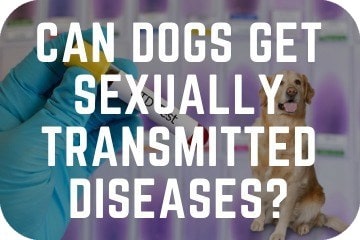
Can Dogs Get Sexually Transmitted Diseases (STDS)? Several common health problems are passed from human to human via a sexual act. Many of these diseases/infections have painful side effects and affect a person’s psychological well-being. A large percentage of humans suffer from STDs worldwide, but the question is, can dogs too?
The answer is, YES! Read below to find out more about the types of STDs, common symptoms, and treatments.
CAN DOGS GET STDS?

As previously mentioned, dogs can catch sexually transmitted diseases from other dogs. Herpes is the most common and often spreads during a breeding session if the necessary precautions are not in place and taken seriously.
If you suspect your dog has an STD, you should immediately phone your veterinarian to seek professional advice; an appointment will most likely have to be booked.
HAS MY DOG GOT A SEXUALLY TRANSMITTED DISEASE (SYMPTOMS)?

To determine whether your dog has caught an STD or not, you will have to first try to remember whether your dog has been sexually active recently. If they have not, then the symptoms are likely to be caused by another disease, infection, or allergy. If they have, you may want to closely check for any blood or discharge coming from the genitalia or any open wounds and sores around that area.
You may notice the dog’s genitals becoming swollen and inflamed, which will cause your dog some pain and irritation. This may make them change their posture and gait. The wounds are likely to be open and produce discharge, which aims to spread the disease to others. Ensure you do not come in contact with this to help stop the spread.
When you take your dog to the vets, they will conduct a number of tests to pinpoint the exact infection, which helps with the treatment process.
WHAT ARE THE TREATMENTS OF STDS IN DOGS?
After the vet has diagnosed the exact cause of the symptoms, they will likely administer antiviral or antibiotic drugs, which are commonly in pill format. The pill format drug is often difficult for your dog to take and digest due to the bad taste. The pill may have to be wrapped or placed inside a tasty treaty such as cheese or some kind of meat. This will entice the dog to eat and swallow it.
As your dog recovers, the vet will recommend keeping it at a distance from other animals to help stop the virus/infection spreading. Even without sexual interaction, the infection can be spread through bodily fluids. Your dog may need several weeks to recover and totally overcome the infection. However, each dog is different and may need more or less time to recover. Some infections, such as herpes, may never go.
The vet may recommend additional testing a few weeks after the diagnosis. This will help to identify if the infection has caused any internal damage to the organs etc.
WHAT ARE THE SIMILARITIES AND DIFFERENCES BETWEEN SEXUALLY TRANSMITTED DISEASES IN DOGS AND HUMANS?
Similarities
> Unfortunately, some STDs in dogs can lead to tumors in dogs that are infected. If these infections are not diagnosed at an early stage and treated, it can have serious consequences and even lead to death.
> Most sexually transmitted diseases will not display symptoms straight away. The infection will incubate inside the dog’s body. After a few weeks, there may be a sudden outbreak of symptoms that are clearly visible.
Differences
> If a human is displaying symptoms of an STD, their sexual partner will likely spot these obvious symptoms and avoid any contact. Unfortunately, dogs are slightly different and will not likely be put off by these symptoms and still carry out the sexual act. For this reason, it is highly recommended that an STD positive dog is isolated and kept away from other dogs for a few weeks until the infection has completely gone.
> The STDs in humans and dogs can display different symptoms due to the ‘strain’ of the disease. This can make it somewhat difficult to diagnose without running a number of tests, which can be costly.
OTHER COMMON DISEASES AND INFECTIONS IN DOGS
Cancer
Cancer is a disease in which a dog’s cells grow uncontrollably, invade surrounding tissue, and spread to other parts of the body. As with people, there are a variety of cancers that dogs can get with different levels of severity. The disease can be classed as localized and generalized. Localized is when the cancer is in tumor form and stays in one area of the body, whereas generalized is the cancers spreading throughout the body to multiple areas.
Symptoms
> Noticeable lumps
> Swelling and inflammation
> Bad smelling breath
> Consistent sores
> Extreme and rapid weight loss
> Difficulty breathing
> Lack of appetite
> Discharge from parts of the body
> Bloody stools
Treatments
> Chemotherapy, radiation, surgery, immunotherapy
> No surgery or treatments means the dog will be the end of life. A high dosage of painkillers will be prescribed if this is the route taken.
Diabetes
Diabetes is a disease in dogs that is caused by a lack of the hormone insulin or a negative response to insulin. After a dog eats, their digestive system breaks the food into various components—one of this being glucose. Glucose is carried to the cells by insulin, a hormone that is secreted in the pancreas. If a dog doesn’t produce enough insulin, their blood sugar levels are likely to increase. This results in hyperglycemia, which, if not treated, can cause many health complications in dogs. Like humans, there are also two types of diabetes in dogs, type I, and type II.
Type I diabetes – Lack of insulin production
Type II diabetes – Lack of insulin production, along with an inadequate response to the hormone.
Symptoms
> Sudden change in appetite
> Dehydration
> Extreme weight loss
> Consistent urination
> Vomiting
> Lethargic
> Loss of vision, blindness
Treatments
> The severity of the diabetes will decide the level of treatment needed.
> Hospitalization for a few days to regulate the blood sugar level
> Oral medication and placed on a high fiber diet
> Insulin Injections
> For female dogs, spaying the dog may be recommended as their hormones can affect blood sugar levels.
Kennel Cough
Kennel cough is the term used to describe a variety of respiratory infections, both viral and bacterial. These infections cause inflammation of a dog’s voice box and windpipe. It is a type of bronchitis and similar to a chest cold that humans can catch.
Symptoms
> Dry cough
> Constant gagging
> Fever
> Discharge from the nostrils
Treatments
> Isolated from other dogs to avoid spreading
> Avoid exposing your dog to steam and smoke
> If your dog pulls against the lead/collar – replace with a harness to reduce irritation
> Kennel cough injection/jab will help prevent the infection
Parvovirus
Parvovirus in dogs’ is a highly contagious disease that produces life-threatening illness.
The virus can attack the cells in a dog’s body, most severely affecting the intestinal tract. Parvovirus can also attack the white blood cells, and if your dog is infected from a young age, the virus can severely damage them.
Symptoms
> Becomes lethargic
> Severe vomiting
> Lack of appetite
> Bloody stools
Treatments
> No medication available at this moment in time to treat parvovirus
> Consistent and professional support needed to help boost the dog’s immune system
> 5-7 days in the dog hospital
> Ensure your dog is vaccinated to help prevent parvovirus
Worms
Dogs can suffer from a variety of parasites; the most common is worms. You can find out symptoms, treatments and enhance your knowledge regarding worms with our post “Can Dogs Die From Worms?”.
FAQS
Why do dogs paw you?
Usually, it is for attention. The attention could be for petting, for food, for a walk, to go potty, to play, or for any other reason.
Pawing is a learned behavior. Your dog may have done it before and received a reward for it (in the form of attention, food, etc.). This then reinforces the behavior. By reinforcing the action, your dog will repeat the pawing in the hope of receiving another reward.
How do dogs get ear mites?
Ear mites are unfortunately very common in dogs and even more common in cats. Ear mites can be easily transferred through dogs sharing the same bed or blanket, as well as being in close confined spaces such as kennels. The ear mites live inside the ear and feed off the dogs ear wax and oils.
Can dogs drink coconut water?
Yes, coconut water is safe for dogs to drink as an occasional treat. It does not replace regular water. Coconut water can be used as a healthy and hydrating drink or used in dog treats. It is rich in carbohydrates, potassium, calcium, and electrolytes. Make sure to use 100% pure coconut water, without any added sugars or sweeteners.
Looking for more pawsome posts? Check these out…
Can Dogs Eat Lettuce?
How To Make A Snuffle Mat
When Do Puppies Lose Their Teeth?
Can Dogs Eat Broccoli?
Can Dogs Eat Watermelon?
Disclaimer: Each dog is different, and every circumstance is different. All efforts have been made to provide accurate information. However, it is not provided by a qualified Veterinarian, Veterinarian Surgeon, or Behaviorist. The information provided is purely educational. The information should not be used as an alternative or substitute for medical care. If you have any health or medical concerns, contact a qualified Veterinary Surgeon or Veterinarian immediately.










No Comment! Be the first one.